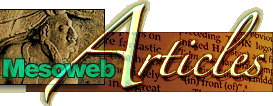

After Maudslay (1889-1902: Vol. 1, Plate 20).

|
The first-ever mention of the ruins of Copan to be found in the archives comes from a letter that explorer Diego García de Palacio wrote in 1576 to King Philip II of Spain. In it, he mentions that the characters that appear on the Copan monuments remind him of monks and bishops.
It is not until 1699 that a second mention of this ancient site appears on record, in an account written by Antonio de Fuentes y Guzmán who, nevertheless, probably never visited Copan in person and based his account on somebody else's version of it. In 1834, as a result of his first official commission by the Government of Central America, Juan Galindo prepared the first illustrated report of Copan, including a rough map, as well as cross-sections and plans of several buildings and even drawings of some of the monuments. To Galindo must also go the credit for conducting the first excavation at the site, when he dug and recorded a tomb in the Eastern Court. In 1839, John Lloyd Stephens and Frederick Catherwood spent several weeks in Copan, clearing the vegetation and carrying out detailed drawings and a map. The publication of their work, in the famous two-volume chronicle of their trip, puts Copan in the world limelight for the first time. Another famous traveler, Alfred P. Maudslay, visited Copan in 1885 and again in 1894, in the course of which he completed some excavation work and made plaster casts of the important monuments then known. His best-known contribution, however, are his superb photographs which to this day remain unsurpassed and an indispensable document for researchers. In the golden age of archaeological expeditions organized by Harvard University's Peabody Museum, several expeditions were put together between the years 1891 and 1895, in the course of which, among other things, the Hieroglyphic Stairway was fully excavated. The prominent Mayanist Sylvanus Morley, working for Washington's Carnegie Institution published The Inscriptions of Copán, which is a complete inventory of the monuments then known. Between 1935 and 1946, the Carnegie Institution excavated and restored, among other things, Ballcourt A, Temple 26's Hieroglyphic Stairway and Structures 11, 12 and 22. With the purpose of determining the function and exploring the city's architectural components, an extensive architectural survey was begun in 1970 by Hasso Hohmann and Annegret Vogrin, the results of which were published in several different reports and journals. In 1985, with a view, among other things, to documenting and reassembling as much as possible of the architectural sculpture fallen from building façades, the Proyecto Mosaicos de Copan was launched under the direction of William Fash. In time, it would be integrated into the wider Proyecto Arqueológico Acrópolis de Copan. The Proyecto Arqueológico Copan, under the aegis of the Honduran Institute for Archaeology and History (IHAH), has become the successor of all previous efforts and is responsible for most of the work carried out in recent times, whether on its own or in association with other institutions. |
home